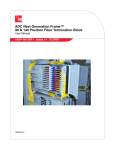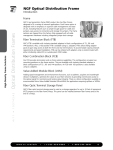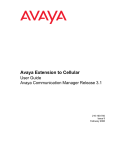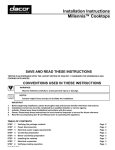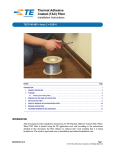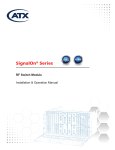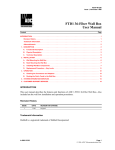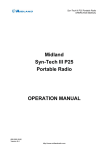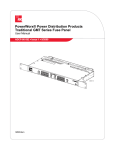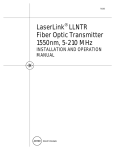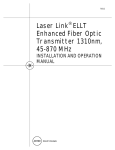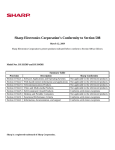Download NGF Fiber Optic Terminal Storage Bay (FOTSB) User Manual)
Transcript
ADCP-90-270 x Issue 1 x March 2000 NGF Fiber Optic Terminal Storage Bay (FOTSB) User Manual) 13987-A Fiber Optic Terminal Storage Bay Content 1 GENERAL.......................................................................... 2 2 PRODUCT DESCRIPTION ............................................................... 2 3 4 1070073 Rev A Page 2.1 Functional Description ........................................................... 2 2.2 Physical Description ............................................................ 3 INSTALLATION ...................................................................... 3 3.1 Securing the Storage Bay to a Frame ................................................. 4 3.2 Securing the Storage Bay to an End Guard .............................................. 6 3.3 Concrete Floor Mounting.......................................................... 7 3.4 Raised Floor Mounting ........................................................... 9 3.5 Removing the Bend Radius Limiter...................................................12 3.6 Cabling .....................................................................15 CUSTOMER INFORMATION AND ASSISTANCE .................................................17 Page 1 © 2000, ADC Telecommunications, Inc. ADCP-90-270 x Issue 1 x March 2000 Revision History ISSUE DATE Issue 1 03/2000 REASON FOR CHANGE Original Trademark Information ADC and ADC Telecommunications are registered trademarks of ADC Telecommunications, Inc. Next Generation Frame is a registered trademark of ADC Telecommunications, Inc. Admonishments Important safety admonishments are used throughout this manual to warn of possible hazards to persons or equipment. An admonishment identifies a possible hazard and then explains what may happen if the hazard is not avoided. The admonishments — in the form of Dangers, Warnings, and Cautions — must be followed at all times. These warnings are flagged by use of the triangular alert icon (seen below), and are listed in descending order of severity of injury or damage and likelihood of occurrence. Danger: Danger is used to indicate the presence of a hazard that will cause severe personal injury, death, or substantial property damage if the hazard is not avoided. Warning: Warning is used to indicate the presence of a hazard that can cause severe personal injury, death, or substantial property damage if the hazard is not avoided. Caution: Caution is used to indicate the presence of a hazard that will or can cause minor personal injury or property damage if the hazard is not avoided. 1 GENERAL This user manual describes the function and installation procedures for the ADC NGF Fiber Optic Terminal Storage Bay. 2 PRODUCT DESCRIPTION 2.1 Functional Description The Next Generation Frame (NGF) Fiber Optic Terminal Storage Bay (FOTSB) is used as a storage apparatus for up to 16.4 feet (5 meters) of equipment (FOT) jumpers at the fiber frame lineup. The FOTSB can be installed between fiber frames within a lineup or between a fiber frame and an end guard at the end of a lineup. Page 2 © 2000, ADC Telecommunications, Inc. ADCP-90-270 x Issue 1 x March 2000 ADDITIONAL FRAME OR END GUARD 13988-A FMDF FRAME SECTION FOT STORAGE BAY Figure 1. Positioning of the Storage Bay within a Fiber Frame Lineup 2.2 Physical Description The FOTSB is 7 feet high and 12 inches wide and is available for use with either the 24-inchdeep Fiber Main Distribution Frame (FMDF) or the 19-inch-deep Front Facing FMDF. The storage bay has vertical cable guides and spools for cable slack storage. 3 INSTALLATION Warning: Never install equipment in a wet location or during a lightning storm. Installation of the storage bay is accomplished by securing the FOTSB to a frame or end guard within a frame lineup. Alternately, the bay can be secured to either a concrete or raised floor. When attached to a frame, junction plates/spacer brackets are used. When attaching to an end guard, “L” mounting brackets are used. Page 3 © 2000, ADC Telecommunications, Inc. ADCP-90-270 x Issue 1 x March 2000 13044-A Figure 2. Securing a Junction Plate/Spacer Bracket 3.1 Securing the Storage Bay to a Frame Using the junction plates/spacer brackets, install the FOTSB as follows: 1. Align the holes in the junction plate/spacer bracket with the mounting holes in the storage bay (Figure 2) and attach using two (2) #12-24 screws (provided). Repeat this step for each of the three sets of holes on this side of the bay. The mounting hole locations are shown in Figure 3. Note: Attaching a junction plate/spacer bracket in the lowest set of mounting holes is optional. The bay will be adequately secured using the upper and middle mounting holes only. Note: To access the lowest of the three sets of holes on the storage bay, it may be necessary to remove the rear kick plate. To do so, remove the four screws that secure the kick plate to the bay and replace after installing the bay to the frame. 2. Move the storage bay into position within the frame lineup. 3. Position the storage bay so that the empty holes in the junction plates are aligned with the mounting holes in the frame. Attach using two (2) #12-24 screws (provided) for each of the junction plates. 4. Repeat this process to secure the storage bay to a frame on the opposite side. Page 4 © 2000, ADC Telecommunications, Inc. ADCP-90-270 x Issue 1 x March 2000 13045-A REMOVE KICK PLATE Figure 3. Junction Plate Mounting Hole Locations Page 5 © 2000, ADC Telecommunications, Inc. ADCP-90-270 x Issue 1 x March 2000 3.2 Securing the Storage Bay to an End Guard Using the “L” mounting brackets, install the FOTSB as follows: 1. Remove the front and rear kick plates on the FOTSB. 2. Secure the mounting brackets (supplied with the end guard) to the storage bay using the 1 /4" bolts, lock washers, and nuts as shown in Figure 4. 3. Slide the end guard into position and secure the protruding edges of the mounting brackets to the end guard using the #12-24 screws (provided). END GUARD 1/4" BOLT MOUNTING BRACKET 13046-A #12-24 SCREWS Figure 4. Attaching an End Guard to the FOTSB Page 6 © 2000, ADC Telecommunications, Inc. ADCP-90-270 x Issue 1 x March 2000 3.3 Concrete Floor Mounting Ensure the appropriate hardware is available for concrete floor mounting. Typically four anchors are used when the FOTSB is floor supported. The anchor has a torque nut with a breakaway cap that breaks away when tightened to the proper torque pressure. Anchor the rack to the floor using the following procedures. 1. Position the bay in its designated floor location. 2. Mark the mounting hole locations on the floor. Use the holes with the widest spacing to provide the greatest stability. See Figure 5. Note: To achieve maximum anchor-holding strength, select exact drill size for hole drilling. 3. Move the bay aside. At each mounting hole location, drill an 18 mm (.07 inch) diameter hole to a depth of 80 mm (3.15 inches) in the concrete. Clean out the hole with compressed air. Check the hole depth with a tape measure or by placing the assembled anchor bolts in each hole. If a reinforcing bar is encountered while drilling, relocate the hole. Fill the unusable hole with locally approved filling product. FRONT 13989-A Figure 5. FOTSB Base Mounting Hole Pattern 4. Ready a floor anchor by placing the components on the stud in the order shown in Figure 6. Ensure that the stud is not extending beyond the bottom of the wedge. Insert the anchor into any of the mounting holes just drilled and tap it in with a hammer until the shoulder of the anchor is just even with the floor. Page 7 © 2000, ADC Telecommunications, Inc. ADCP-90-270 x Issue 1 x March 2000 BREAKAWAY CAP PLASTICENCLOSED TORQUE NUT STUD NOTE: FOR FUTURE REMOVAL OF TORQUE NUT AND/OR THREADED ROD, USE A SCREWDRIVER TO SNAP OFF THE PLASTIC COVER EXPOSING THE TORQUE NUT. ALWAYS REPLACE NUT WITH A NEW TORQUE NUT. WASHER PLASTIC COVER SHOULDER TORQUE NUT DISCARD BREAKAWAY CAP WEDGE 8013-C Figure 6. Floor Anchor 5. Using a deep socket or box-end wrench, secure the anchor in the floor by tightening the torque nut breakaway cap until it just starts to feel snug. (Do not tighten until the breakaway cap breaks away from the plastic-enclosed torque nut.) Remove the washer, plastic-enclosed torque nut, and attached breakaway cap from the stud. 6. Repeat steps 4 and 5 above for each of the remaining floor anchors to secure them in the remaining mounting hole locations. Depending on the type of installation, you will have either two or four anchors to install. 7. After securing all the anchors in the floor as just described, position the storage bay over the anchors. Level the bay using shim plates, if necessary, as shown in Figure 7. Page 8 © 2000, ADC Telecommunications, Inc. ADCP-90-270 x Issue 1 x March 2000 PLASTIC-ENCLOSED TORQUE NUT WITH BREAKAWAY CAP WASHER STORAGE BAY BASE HOLD DOWN BAR SQUARE WASHERS HOLD DOWN PLATES AND SQUARE WASHERS SHIM AS REQUIRED STORAGE BAY BASE SHIM AS REQUIRED FLOOR LINE 13990-A Figure 7. Shim and Hold Down Bars 8. Place a hold down bar and one or two square washers, as required, on each stud. Replace the flat washers and torque nuts removed in the previous steps. Tighten each torque nut until the breakaway cap breaks away, indicating that the anchor is properly set. Discard the breakaway caps. 3.4 Raised Floor Mounting Various methods are used to mount equipment racks/bays to a raised floor. The method described here uses mounting hardware available in a kit from ADC. For other methods, follow the instructions provided with that equipment. Table 1 lists the ADC kit contents. The length of threaded rod required will depend on the raised floor height above the regular floor. Page 9 © 2000, ADC Telecommunications, Inc. ADCP-90-270 x Issue 1 x March 2000 Table 1. Raised Floor Mounting Kit (FDF-ACC136) Contents ITEM QUANTITY Unistrut (feet) 10 Flat washer – 0.625 in. (16 mm) 12 Lock washer – 0.50 in. (12.7 mm) 12 Threaded rod 1/2–13 u 30 in. (76 cm) 4 Insulating shoulder washer 4# Anchor kit 1 Flat washer – 0.50 in. (12.7 mm) 12 Hex nut (1/2–13) 12 Spring nuts – (1/2–13) 4 # = Optional Ensure the appropriate hardware is available to satisfy raised floor mounting requirements. The following procedures cover a single storage bay placement. If more bays/racks in a line-up are being placed, the Unistrut lengths and positions of anchors in the lower floor must be adjusted accordingly. The anchor placed in the concrete floor is designed with a threaded stud and torque nut with a cap that will break away when tightened to the proper torque pressure. Prepare the raised floor support and anchoring hardware using the following procedures. 1. Position the storage bay in its designated floor location. Mark the mounting holes as shown on the equipment rack footprint. See Figure 8. 2. Move the bay aside. Drill four 16 mm (0.625 inch) clearance holes in the raised floor panel(s). 3. Remove any adjacent floor panels as needed to gain access to the lower floor. 4. Mark the lower floor in line with the holes in the raised floor panels. Use a plumb line or equivalent for an accurate mark. See Figure 8. 5. Draw an extended line through the centers of the mounting hole marks. 6. Cut two pieces of Unistrut into 36.0 inch (91.4 cm) lengths. Drill two 16 mm (0.625 inch) holes located 6.0 inches (15.2 cm) from each end. 7. Place the Unistrut on the lines made in step 5. Center along the line and mark the floor for the Unistrut anchor holes. Move the Unistrut out of the way for now. 8. Drill an 18 mm (.07 inch) diameter hole to a depth of 3.15 inches (80 mm) in the concrete at the marks made in step 7. Clean out the hole with compressed air. Check the hole depth with a tape measure or by placing an assembled anchor in each hole. If a reinforcing bar is encountered while drilling, relocate the hole. Fill the unusable hole with locally approved filling product. 9. Insert the anchors into each hole. Check that each anchor shoulder is even with the floor. Use a deep socket or box-end wrench and tighten the torque nut until the anchor is just snug. Do not tighten until the torque nut cap breaks way. Repeat for each anchor. Refer to Figure 9. Page 10 © 2000, ADC Telecommunications, Inc. ADCP-90-270 x Issue 1 x March 2000 EQUIPMENT RACK FOOTPRINT MARK HERE E C XT EN E TE ND R ED LI N E RAISED FLOOR PANEL UNISTRUT ANCHOR HOLE CONCRETE FLOOR UNISTRUT ANCHOR HOLE RACK MOUNTING REFERENCE HOLES 14003-A Figure 8. Rack Mounting Hole Markings 10. Remove the nut and washer from the studs. Position the Unistrut over the studs. Replace the flat washer and torque nut onto the stud. Tighten the torque nut until the torque cap breaks away, indicating the anchor is properly set. Discard the break-away portion of the torque nut. Repeat for each anchor. 11. Insert spring-nuts into the Unistrut, aligning them with marks on the floor made in step 4. See Figure 9. 12. Replace as many floor panels as possible while still allowing access to the lower floor. Position the equipment rack over the clearance holes in the floor panel. 13. Cut two lengths of Unistrut approximately 12.0 inches (30.5 cm) long. Mark the Unistrut at the hole positions of the raised floor made in step 2. Drill two 16 mm (0.625 inch) holes in the Unistrut. 14. Measure from the lower floor to the base of the equipment rack allowing sufficient length for leveling shims, hold down bar, washers, and nuts. 15. Place onto one end of the threaded rods, in order: 5/8-inch (16 mm) flat washer, 1/2-inch (12.7 mm) flat washer, 1/2-inch (12.7 mm) lock washer, two - 1/2-inch (12.7 mm) hex nuts, 1/2-inch (12.7 mm) lock washer, 1/2-inch (12.7 mm) flat washer, 5/8-inch (16 mm) flat washer. On top of the pile up, place the shorter length Unistrut over the threaded rods. You may find it easier to have someone hold the Unistrut beneath the raised floor panel for step 16. See Figure 9. Page 11 © 2000, ADC Telecommunications, Inc. ADCP-90-270 x Issue 1 x March 2000 EQUIPMENT RACK BASE (FRONT) 1/2 IN. HEX NUT 1/2 IN. LOCK WASHER 1/2 IN. FLAT WASHER NYLON SHOULDER WASHER HOLD DOWN BAR SHIM AS REQUIRED RAISED FLOOR PANEL ;;; ;; ;;;;; 5/8 IN. FLAT WASHER 1/2 IN. FLAT WASHER 1/2 IN. LOCK WASHER 1/2 IN. HEX NUT UNISTRUT 1/2 IN. THREADED ROD SPRING NUT ANCHOR ASSEMBLY UNISTRUT CONCRETE FLOOR 8599-A Figure 9. Typical Raised Floor Anchor Arrangement 16. Hold the above arrangement in place while inserting the threaded rod up through the floor panel from below, up into the equipment rack base. Thread the rod down into the floor Unistrut spring nuts, then hand-tighten the lower hex nut. Repeat for each rod. 17. Thread the upper hex nut upward until the shorter Unistrut touches the bottom of the raised floor panel. 18. Place onto the upper end of the threaded rod (rack base end) the following items: 5/8-inch (16 mm) flat washer, 1/2-inch (12.7 mm) flat washer, 1/2-inch (12.7 mm) lock washer, and 1/2-inch (12.7 mm) hex nut. 19. Align the equipment rack and tighten securely. Start with the floor Unistrut, then the Unistrut under the raised floor and last the rack base. 3.5 Removing the Bend Radius Limiter Removal of the bend radius limiters is recommended when using the FOTSB with a Next Generation Frame that contains OSP cable. Removal of the radius limiters opens the vertical cable guides, which allows easier routing of OSP cable. Perform the following procedure to remove the radius limiters: 1. Remove the two mounting screws that secure the vertical cable guide to the bay (Figure 10). Set the screws aside. Page 12 © 2000, ADC Telecommunications, Inc. ADCP-90-270 • Issue 1 • March 2000 13715-A MOUNTING SCREWS Figure 10. Vertical Cable Guide Mounting Screws 2. Remove the assembly from the bay (Figure 11). 13712-A Figure 11. Removing the Vertical Cable Guide/Radius Limiter Assembly Page 13 © 2000, ADC Telecommunications, Inc. ADCP-90-270 • Issue 1 • March 2000 3. Place the removed vertical/limiter assembly on a stable surface and remove the two mounting screws that secure the bend radius limiter to the vertical cable guide (Figure 12). MOUNTING SCREWS 13713-A MOUNTING HOLES Figure 12. Bend Radius Limiter Mounting Screws 4. Remove bend radius limiter (Figure 13). 13714-A Figure 13. Removal of the Bend Radius Limiter 5. Reattach the vertical cable guide to the bay using the mounting screws removed in step 1. Page 14 © 2000, ADC Telecommunications, Inc. ADCP-90-270 x Issue 1 x March 2000 3.6 Cabling 3.6.1 Overhead Cabling Figure 14 shows the recommended routing of FOT jumpers when dropping from overhead. Note: To maintain cable integrity, do not store more than 16.4 feet (5 meters) of cable per storage bay. FOT FOT STORAGE BAY OSP BAY 1 OSP OSP BAY 2 OSP FOT BAY 3 FOT STORAGE BAY 13666-A Figure 14. FOT Overhead Jumper Routing Page 15 © 2000, ADC Telecommunications, Inc. ADCP-90-270 x Issue 1 x March 2000 3.6.2 Raised Floor Cabling Figure 15 shows the recommended routing of FOT jumpers when bringing the cable up through a raised floor. Note: To maintain cable integrity, do not store more than 16.4 feet (5 meters) of cable per storage bay. FOT STORAGE BAY BAY 1 FOT BAY 2 OSP OSP BAY 3 OSP OSP FOT STORAGE BAY FOT 13991-A Figure 15. FOT Raised Floor Jumper Routing Page 16 © 2000, ADC Telecommunications, Inc. ADCP-90-270 x Issue 1 x March 2000 4 CUSTOMER INFORMATION AND ASSISTANCE For customers wanting information on ADC products or help in using them, ADC offers the services listed below. To obtain any of these services by telephone, first dial the central ADC telephone number, then dial the extension provided below. The central number for calls originating in the U.S.A. or Canada is 1-800-366-3891. For calls originating outside the U.S.A. or Canada, dial country code “1” then dial 952-946-3000. Sales Assistance Extension 3000 • Quotation Proposals • Ordering and Delivery • General Product Information Systems Integration Extension 3000 • • • • • • • Complete Solutions (from Concept to Installation) Network Design and Integration Testing System Turn-Up and Testing Network Monitoring (Upstream or Downstream) Power Monitoring and Remote Surveillance Service/Maintenance Agreements Systems Operation BCG Technical Assistance Center Extension 3475 E-Mail: [email protected] • • • • • • Technical Information System/Network Configuration Product Specification and Application Training (Product-Specific) Installation and Operation Assistance Troubleshooting and Repair Product Return Department Extension 3748 E-Mail: repair&[email protected] • ADC Return Authorization number and instructions must be obtained before returning products. Product information may also be obtained using the ADC web site at www.adc.com or by writing ADC Telecommunications, Inc., P.O. Box 1101, Minneapolis, MN 55440-1101, U.S.A. Contents herein are current as of the date of publication. ADC reserves the right to change the contents without prior notice. In no event shall ADC be liable for any damages resulting from loss of data, loss of use, or loss of profits and ADC further disclaims any and all liability for indirect, incidental, special, consequential or other similar damages. This disclaimer of liability applies to all products, publications and services during and after the warranty period. This publication may be verified at any time by contacting ADC’s Technical Assistance Center at 1-800-366-3891, extension 3475 (in U.S.A. or Canada) or 952-946-3000 (outside U.S.A. and Canada), or by writing to ADC Telecommunications, Inc., Attn: Technical Assistance Center, Mail Station #71, P.O. Box 1101, Minneapolis, MN 55440-1101, U.S.A. © 2000, ADC Telecommunications, Inc. All Rights Reserved Printed in U.S.A. Page 17


















